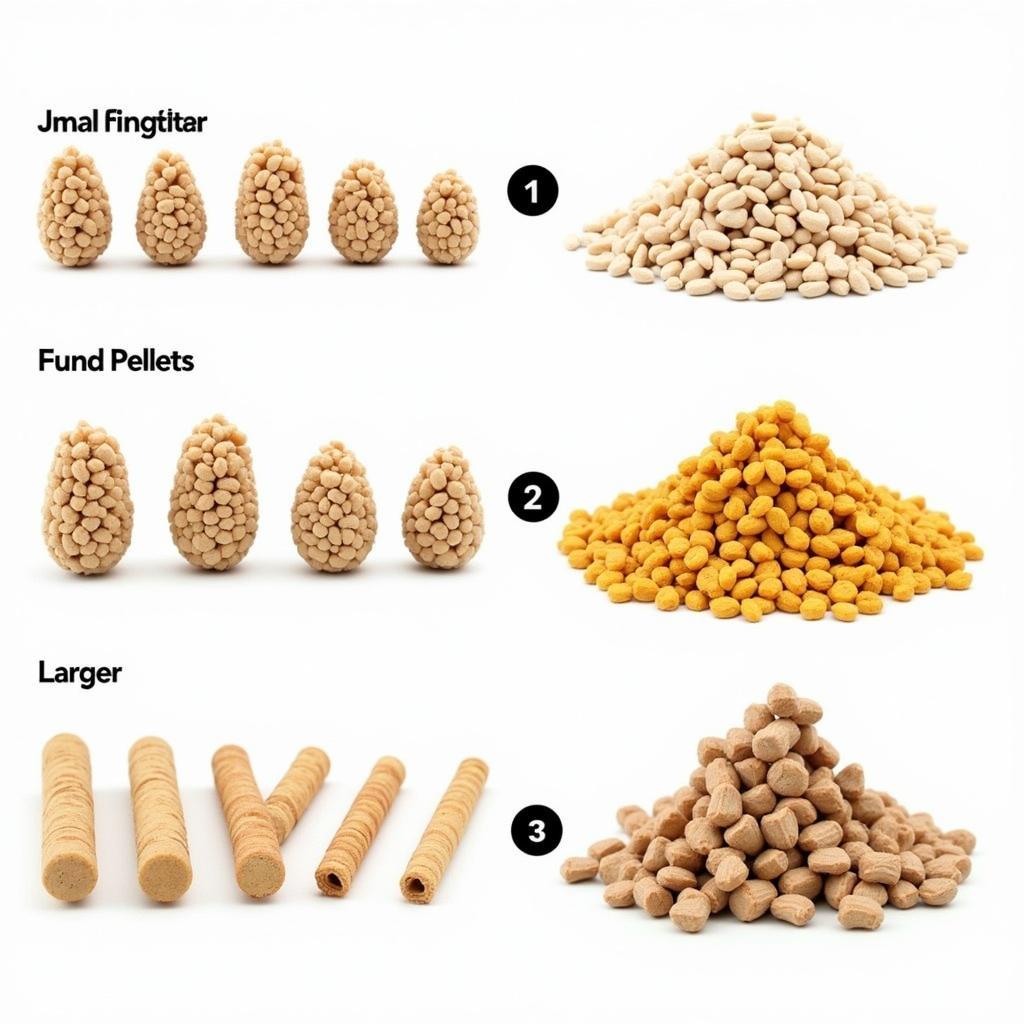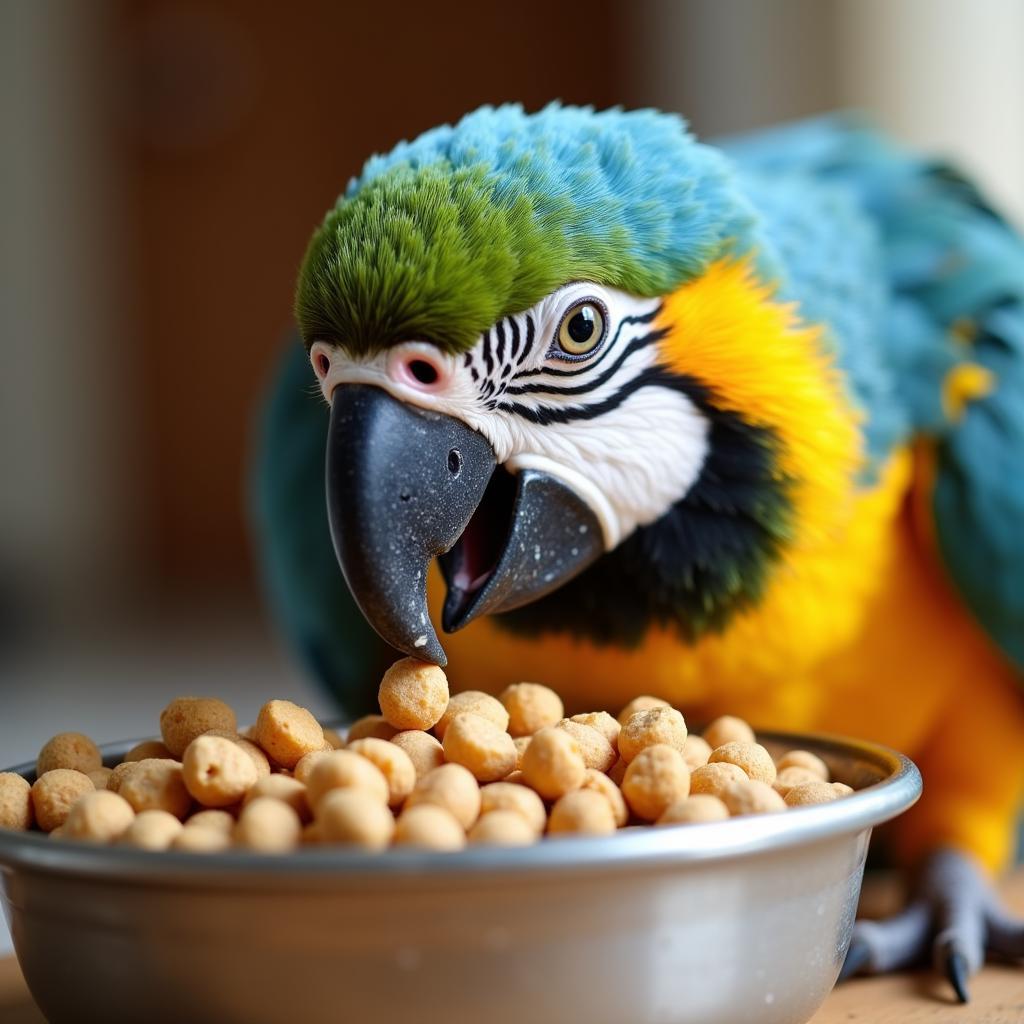Bird Pellets Food has become increasingly popular among bird owners, and for good reason. This specially formulated diet offers a balanced nutritional profile, unlike seed-based diets, ensuring your feathered friend receives all the essential vitamins and minerals for a healthy and vibrant life. Let’s delve into the world of bird pellets, exploring their benefits, different types, and how to successfully transition your bird to this optimal diet.  Various types of bird pellets
Various types of bird pellets
Decoding the Nutritional Value of Bird Pellets
Unlike seeds, which birds can selectively eat, leading to nutritional deficiencies, bird pellets offer a complete and balanced diet in every bite. They are typically made from a mix of grains, seeds, fruits, vegetables, and essential vitamins and minerals, ensuring your bird receives a consistent and optimal intake of nutrients.  A bird enjoying a meal of pellets
A bird enjoying a meal of pellets
Why Choose Pellets Over Seeds?
Many bird owners wonder, “Are pellets really better than seeds?” The answer is a resounding yes, especially in the long term. Seed-based diets are often deficient in essential vitamins and minerals, like vitamin A and calcium, which are crucial for a bird’s overall health. This can lead to various health issues, from weakened immune systems to brittle bones. Pellets eliminate this risk by providing a complete nutritional profile in every pellet. They also reduce the likelihood of selective eating, a common problem with seed mixes where birds pick out their favorite (and often less nutritious) seeds.
Transitioning Your Bird to a Pellet Diet
Switching a bird from a seed-based diet to pellets can sometimes be challenging. Here’s a step-by-step guide to help you through the process:
- Introduce pellets gradually: Start by mixing a small amount of pellets with your bird’s current seed mix.
- Increase the pellet ratio: Slowly increase the proportion of pellets in the mix while decreasing the seeds.
- Offer pellets in different forms: Try offering pellets in different shapes, sizes, and flavors to find what your bird prefers. Some birds prefer crumbles, while others enjoy larger, extruded pellets.
- Be patient and persistent: The transition may take time, so be patient and consistent with your efforts. Don’t give up if your bird initially resists the pellets.
- Make pellets appealing: Offer moistened pellets or mix them with chopped vegetables or fruits to make them more enticing.
You can find suitable bird food holder for cage to facilitate the transition.
Choosing the Right Bird Pellets
Not all bird pellets are created equal. It’s essential to choose a high-quality pellet formulated specifically for your bird’s species. Factors to consider include your bird’s age, size, and specific dietary needs. For example, psittacus bird food offers specialized options. Consulting with an avian veterinarian can help you determine the best pellet brand and type for your feathered companion.
What are the different types of bird pellets?
Bird pellets come in a variety of shapes, sizes, and formulations. Common types include:
- Extruded pellets: These are the most common type, typically cylindrical or spherical in shape.
- Crumbled pellets: Smaller and softer, crumbled pellets are ideal for smaller birds or those with difficulty chewing larger pellets.
- Seed-coated pellets: These pellets are coated with seeds to entice seed-loving birds to try pellets.
The Importance of Fresh Food and Water
While pellets provide a complete and balanced diet, they shouldn’t be the sole component of your bird’s diet. Fresh fruits, vegetables, and access to clean, fresh water are also essential for optimal health. Consider adding rat food pellets occasionally for variety.
Dr. Emily Carter, DVM, an avian veterinarian with over 20 years of experience, emphasizes, “Pellets form the foundation of a healthy diet, but variety is key. Supplementing with fresh produce ensures your bird receives a wider range of nutrients and stimulates their foraging instincts.”
Similarly, Dr. Robert Miller, a renowned avian nutritionist, states, “Switching to a pellet-based diet can significantly improve a bird’s long-term health, reducing the risk of nutritional deficiencies and related health problems.”
Conclusion
Switching to bird pellets food is a crucial step towards ensuring your feathered friend lives a long, healthy, and vibrant life. While the transition may require patience and persistence, the long-term benefits are undeniable. By choosing high-quality bird pellets and supplementing with fresh foods and water, you’re providing your bird with the best possible nutrition for a happy and fulfilling life. Remember to consider meat bird food and insect protein cat food for other pets.
FAQ
- Are all bird pellets the same?
- How do I transition my bird to pellets if they are resistant?
- Can I give my bird treats while they are on a pellet diet?
- How much should I feed my bird daily?
- How long do bird pellets last?
- Can I mix different brands of pellets?
- Are colored pellets safe for birds?
When in need of assistance, feel free to reach out. Contact us at Phone Number: 02437655121, Email: minacones@gmail.com, or visit us at 3PGH+8R9, ĐT70A, thôn Trung, Bắc Từ Liêm, Hà Nội, Việt Nam. We have a 24/7 customer support team.